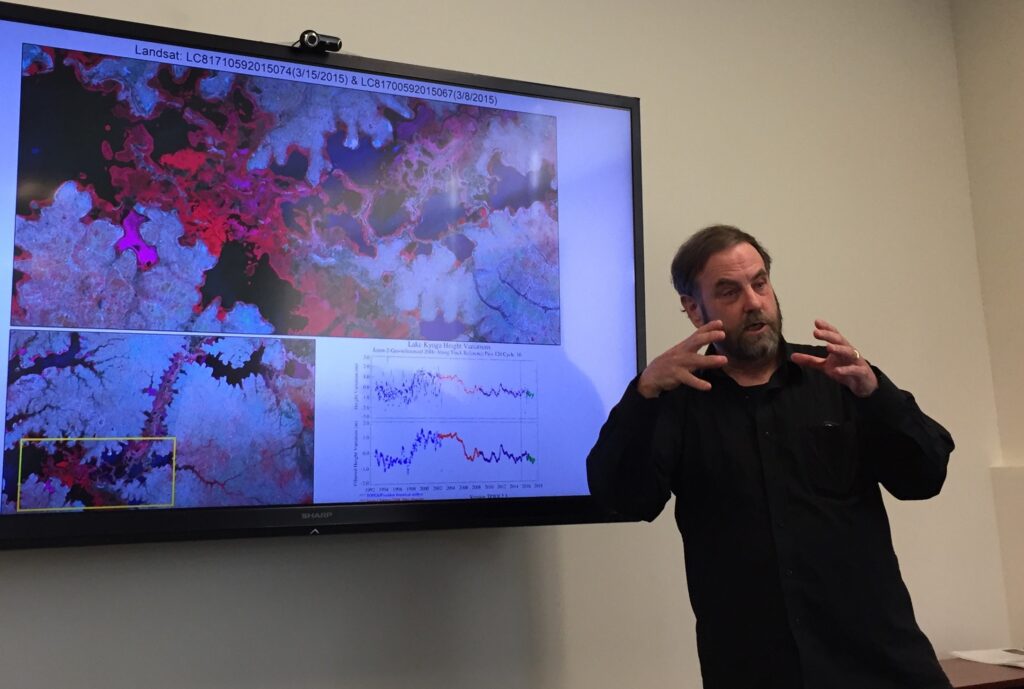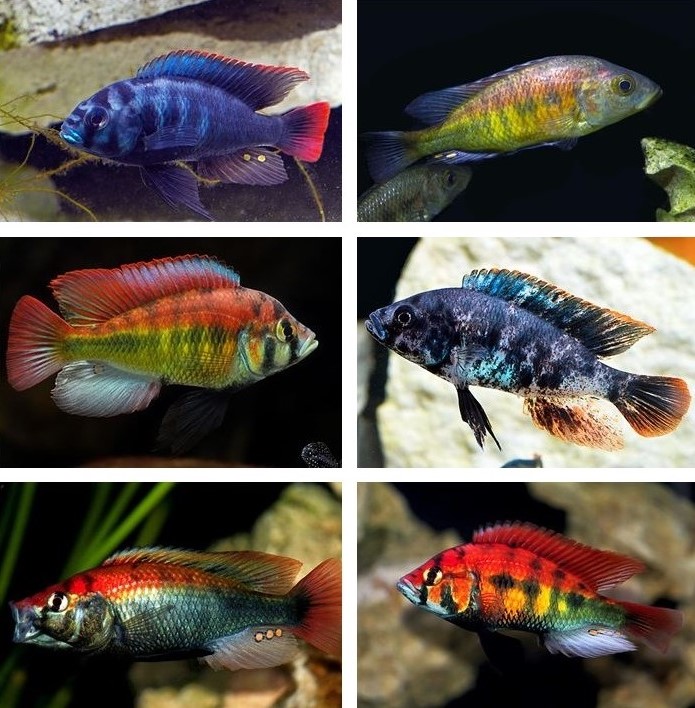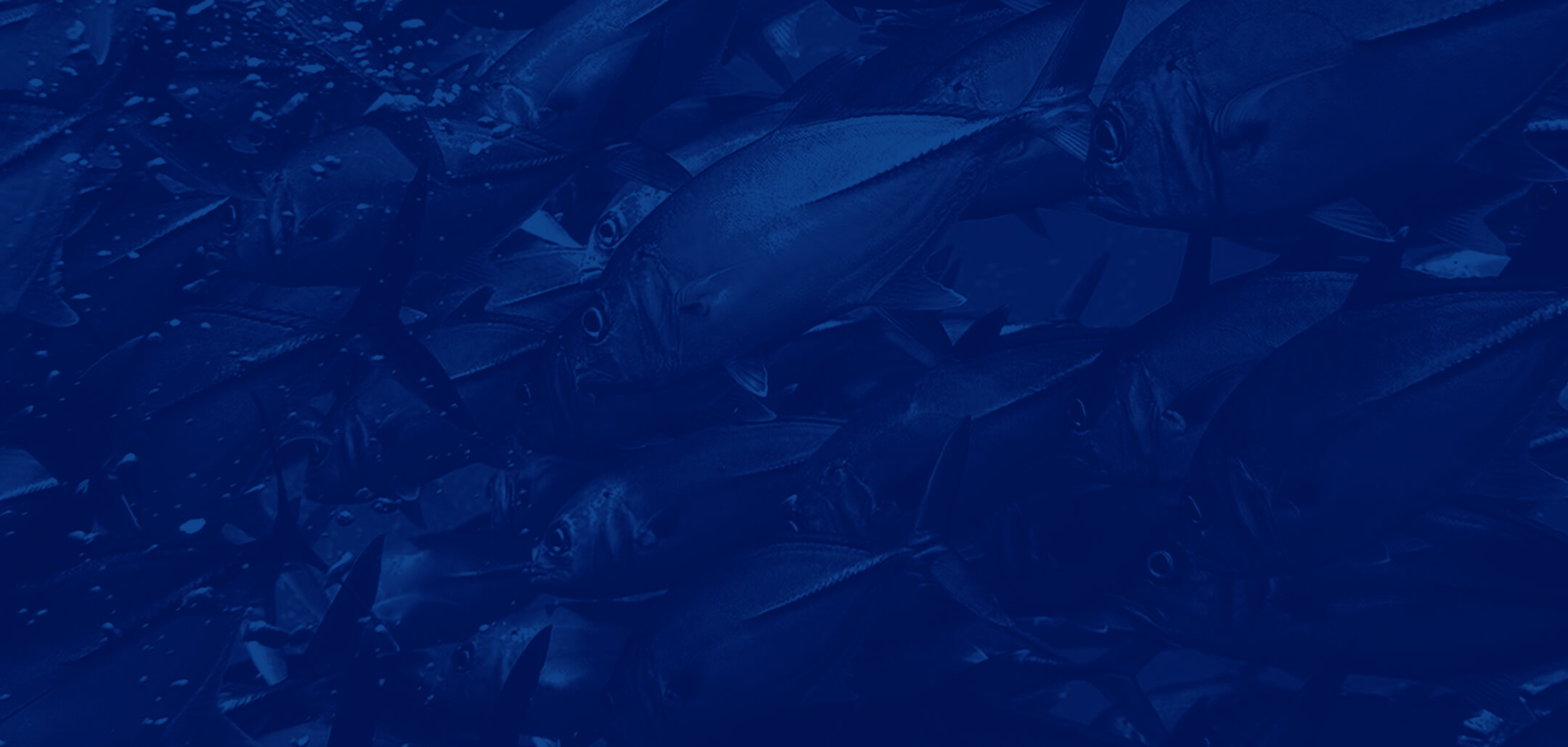Visitors might not gravitate to the simple-looking African cichlid fish in Mote Aquarium’s exhibit “Oh Baby! Life Cycles of the Seas” — but its plain appearance belies an important backstory. These black or silver fish of the species Astatotilapia piceata (also called Haplochromis piceatus) may be extinct in the wild, according to new findings shared by a Boston University (BU) professor who spent January through March this year as a visiting scientist at Mote Marine Laboratory.
Dr. Les Kaufman, Professor of Biology with BU’s Marine Program, spent much of the first quarter of 2018 in Sarasota, collaborating with Mote’s coral reef researchers. In Mote Aquarium he spotted an old friend from his other line of research: A. piceata, a fish native to Africa’s environmentally threatened Lake Victoria. This species is now bred by U.S. and European aquarium professionals under a Species Survival Plan whose predecessor program Kaufman launched in 1987.
Mote staff are caring for the A. piceata as part of the current Species Survival Plan overseen by the Association of Zoos and Aquariums (AZA) — and they were fascinated but saddened to learn that wild A. piceata might be gone forever.
Kaufman, who has studied fishes in and around Lake Victoria since 1987, is sharing the story of A. piceata and its hundreds of diverse “cousins,” in hopes of informing and fueling efforts to secure their future. Some of these efforts might eventually call upon southwest Florida scientists and aquarists.
Questions & answers with Kaufman

- What is so interesting about Lake Victoria and its fishes?
Lake Victoria is the world’s second largest lake, just shy of Lake Superior. It’s full of a spectacular array of fishes of many different evolutionary lineages, but most derived very recently from a tiny handful of ancestors. The group that includes A. piceata, the haplochromine cichlids, has 14 functional types of fishes in Lake Victoria, each with subtypes. There are skulking predators that feed like largemouth bass. Another type hides behind blades of (aquatic plants) and ambushes prey. Another one grabs the prey head first and flenses it of scales. Another one follows females of other cichlid species that brood their young in their mouths, and when they’re going to release their young it rushes in and eats them. Another group of species are nicknamed “baby suckers.” One of these will sidle up to a female with young in her mouth, disguised as a sister. Then it wheels around the front, sucks in the head of the prey, hooks in its teeth, shakes it and sucks all the babies out. Our A. piceata eats large zooplankton (small animals drifting through the water, in this case mostly the aquatic larvae of mosquito-like insects).
A huge diversity of cichlid fishes has evolved in Lake Victoria and the region over a relatively short time, and they’re continuing to evolve. This is a place where we can see evolution in action, which is very interesting.
About 600 fish species used to live in the Lake, but now, about 300 of them are already extinct.
Photos: Examples of the beautiful diversity of haplochromine cichlids (captions and rest of story below)

- What caused these extinctions?
The disappearance of haplochromine cichlids was blamed on the introduction of nonnative Nile perch, a food fish introduced by the British in 1954 and again in the early 1960s when a Ugandan hatchery flooded out. But it took the perch another 20 years to learn to live and reproduce there. Once they did, they went from 2 percent of the biomass to 80 percent over about three years. They obviously made some kind of discovery.
The assumption was that the Nile perch ate the haplochromine cichlids, but this has come under scrutiny. Other curses were visited on the Lake in the same time period — for example, an outbreak of the water hyacinth we’re familiar with here in Florida. Those were fed by deforestation dislodging nutrient-rich soil that flowed into the Lake. This also fueled phytoplankton blooms (high concentrations of microscopic algae), aided and abetted by massive burning in the Congo basin that produced enormous amounts of particulate nutrients.
There was a big breakthrough in 2015, when Paul van Zwieten and others, looking at decades of climate data, finally understood, I think, why things had gotten so bad. Over a time period roughly corresponding to my work in Africa, the prevailing winds died. When that happened the lake stopped turning over, and three-quarters of the lake went anoxic (severely oxygen depleted), and Paul pieced together this story: The Nile perch are not the reason the haplochromines went extinct. The haplochromines are the reason the Nile perch took so long to explode. The haplochromines were 80 percent of fish biomass, and were eating the larvae of Nile perch. When lake went anoxic, many haplochromines were cleared out, and that allowed an immense jump in larval survival of Nile perch. Not everyone is convinced by this, but I think it’s very interesting. - So the A. piceata housed at Mote were among the species that went extinct in Lake Victoria?
We don’t have current evidence that they’re there. If we don’t see a species for 50 years, we are calling it extinct. Lake Victoria never ceases to confound: some times that we thought we’d rediscovered a missing species, it’s turned out to be a completely new form — often of hybrid origin — that just happened to show some of the distinctive characteristics of the missing actor. - How do you know which fish species are still in Lake Victoria?
I’ve been co-leading, remotely in this case, the first synoptic fish biodiversity survey of Lake Victoria… amazingly, I think, ever. This is through an active National Science Foundation grant to the University of Denver and Boston University. The project lead, Sarah Glaser, is part of an operation called “Secure Fisheries,” which is in turn part of the NGO OneEarth Future, affiliated with the University of Denver.
The surveys involve three fishery research institutes from the three different countries on the lake (Uganda, Kenya and Tanzania). They include gillnet surveys of nearshore habitats, a trawl survey offshore in deeper water, an acoustic survey — that’s like sonar — and trawls associated with acoustic surveys targeting the deepest parts.
But of course, our reach is limited; this place is huge. - Why is it so important to understand and support healthy fisheries in Lake Victoria?
Fishing is important to the people living around the Lake — for food, livelihoods, culture and medicine. As the Secure Fisheries website states: “Fishing communities around the lake face several challenges, including declining wild fisheries and a large gap between the amount of fish consumed and that recommended by the World Health Organization. Malnutrition rates, especially in women and children, are high in fishing villages.”
There were originally subsistence fishermen around Lake Victoria, but British colonization brought modern conveniences and tools in the early 20th century that contributed to the destruction of important natural fish populations. The introduced Nile perch spawned a $300-million-a-year export fishery, but that contributed to the massive extinction of endemic species, plummeting water quality, and socio-economic dynamics that exacerbated regional malnutrition, enabled an explosion in prostitution and AIDS, and provided a source of protein (a small native minnow that swims in vast shoals) to insurgency groups that plowed through the jungle and attacked villages by surprise.
The native haplochromine cichlids are food fishes themselves, or they are food for other food fishes. So from a purely utilitarian standpoint, there’s a reason to conserve them. - How can scientists and aquarium professionals advance conservation for these fishes and their habitat?
Instead of focusing on extinction so much, we should focus on preserving evolutionary processes — let the fish evolve to keep pace with changes in the Lake, as long as there is stock there to do it. The evolutionary force is still at work there. Some species have hybridized (two different species interbred). That’s one way to avoid extinction, but now you have a new hybrid lineage. That’s still a form of resilience. Who are we to say which of those species should survive? We need to ensure a supportive, enabling environment for the native fish communities to survive in some continuously adapting and still richly diverse form.
With the A. piceata, like the ones at Mote, and the five other haplochromine cichlids housed in the U.S. and Europe under the Species Survival Plan, one assumption has been that we’ll reintroduce them to the wild someday, but that would be risky. For example, we don’t know if they would bring new diseases back to Lake Victoria – which could be catastrophic.
However, we can work with them to answer many questions at lower cost and lower risk in the U.S., and transfer knowledge and practices to others working in Africa. For instance, if we were to raise them in aquaculture ponds, would there be genetic selection for the ones that do best in a pond, rather than the Lake? How many generations could we raise before they evolve traits not found in the wild? These fishes evolve quickly and that’s positive in nature, but what does it mean for the fish raised by us, or ultimately, people in Africa?
However, the experiments we can do will have value. Even if the value is limited for Lake Victoria cichlids, it may benefit other faunas. If we know the most useful tools for conservation, whether involving captive propagation or not, we and our African colleagues might be able to do something beneficial in the field- beneficial for wildlife conservation, and thus beneficial for today’s children and theirs.
Avid and knowledgeable U.S. aquarists, whom we call para-professionals, have done an enormous amount. Last year we established a formal partnership at the Regional Aquatics Workshop meeting with para-professionals in North America and Europe to help amplify populations of Species Survival Plan fishes for field experiments that we hope to conduct at the Tropical Aquaculture Lab in Ruskin, Florida, and potentially here at Mote Aquaculture Research Park in Sarasota County if we can raise the funds.
We need to build strong bridges between AZA-accredited zoos and aquariums and field research. If we add other key elements – an organized conservation science community in Africa, and efforts to protect and improve water quality and lakeside habitat that affects it –we have the ingredients for a conservation effort. Our goal is to have as many as possible of the endemic species in east Africa survive.


